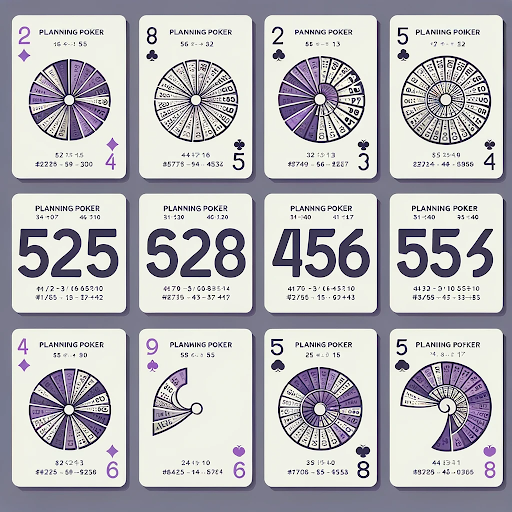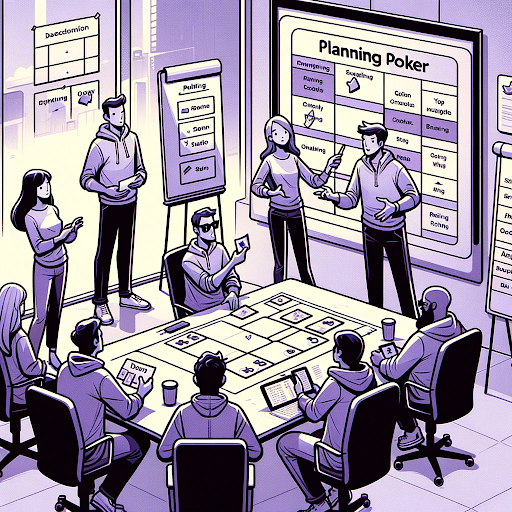Ever heard of planning poker? It’s not what you’d play in Vegas, but it’s a game-changer for Agile teams. Sometimes, people refer to it as Scrum poker.
Are you a product manager? Understanding planning poker is like having an ace. It’s a vital tool for boosting productivity and ensuring everyone on your team is on the same page.
Breaking down planning poker
Imagine you’re playing a card game. Instead of playing for chips, you estimate how much work a project will take. That’s planning poker in a nutshell. It’s a simple yet powerful way for Agile teams to determine the effort needed for different tasks.
You use a special deck of cards, each with a number representing work effort. The higher the number, the more complex the task. When a new task comes up, each team member picks a card that matches the required effort. Then, everyone reveals their cards at once to keep things fair and unbiased. If there’s a big difference in guesses, you’ll have a chat about it until everyone agrees.

Planning poker’s roots
Planning poker started turning heads in Agile around 2002, thanks to James Grenning and Mike Cohn. Agile methodologies were gaining traction. The need for more effective estimation techniques became evident.
James Grenning is a pioneer in the Agile and Extreme Programming (XP) spaces. He introduced this technique as a more engaging and accurate way to estimate project work.
Mike Cohn, a key figure in the Agile community, put planning poker on the map. In his 2005 book “Agile Estimating and Planning,” he described the method in detail. He also championed its benefits, highlighting how it:
- Fosters collaboration
- Provides a consensus-based approach to estimation
- Injects a bit of fun into the often dry process of project planning
Initially, people practiced planning poker with physical card decks – a nod to its poker game analogy. These decks were not your typical playing cards. They were specifically designed with the Fibonacci sequence or similar progressive scales to represent the complexity and effort of tasks. This tangible element made estimations more interactive and grounded.
As Agile methodologies evolved, so did planning poker. Today, everyone does it digitally.
Planning poker is now a part of various Agile methodologies, including Scrum and XP. Small startups and large corporations use it. It’s easy, transparent, and really cuts down on guesswork in project planning.
Why planning poker is excellent for Agile teams
Agile is all about being quick and adaptable. Teams work in short bursts, constantly tweaking and improving. Planning poker fits right into this cycle.
It aligns with Agile’s fast-paced cycles
Before each sprint, your team determines how much effort each task will need. It’s a democratic process where everyone’s opinion counts. This leads to more accurate planning and better communication.
Agile methodology thrives on speed and flexibility. The Agile team consists of sprinters. They move fast, embrace change, and constantly seek ways to improve. This is where planning poker really shines. It perfectly dovetails with Agile’s dynamic rhythm.
It fosters democratic estimations
Planning poker is not just about coming up with numbers. It’s a democratic process that values each team member’s perspective.
In a typical session, everyone has an equal say in the estimation after a user story is presented. This inclusivity is vital in Agile teams where cross-functional collaboration is critical. Planning poker allows each member to voice their opinion and estimate. This way, it ensures that a task’s different aspects and potential challenges are considered. This collective intelligence approach leads to more reliable and realistic estimations.
It enhances communication and understanding
Planning poker isn’t all about numbers. It’s also a fantastic communication tool. When individual estimates differ, it sparks a conversation. These discussions are gold mines for insight. They reveal different understandings of the task, assumptions, and potential risks. This is especially beneficial in Agile, where understanding and adapting to requirements is continuous. Through these discussions, team members align their understanding of each task. This creates a more cohesive and informed team.
It builds team cohesion and commitment
There’s another less talked about but equally important aspect of planning poker in Agile.
Team members feel more connected and committed to their decisions. This sense of ownership and team spirit is crucial in Agile. After all, team dynamics directly impact productivity and project success.
It streamlines sprint planning
Finally, planning poker streamlines the sprint planning process. In Agile, time is of the essence, and long, drawn-out meetings can be counterproductive.
Planning poker has a structured yet flexible approach. It keeps sprint planning focused and efficient. It also helps teams quickly assess the effort needed for tasks. As a result, it paves the way for a more streamlined and effective sprint.
When to run a planning poker session
Timing planning poker sessions correctly can significantly enhance their effectiveness. It can also ensure they positively contribute to the project’s lifecycle. Here are a few ideas for timing your planning poker sessions.
- At the beginning of sprint planning
This is the most common and strategic time to hold a planning poker session. That’s when the team needs to commit to a set of tasks for the upcoming sprint. Planning poker helps in accurately estimating the effort required for each task. This is essential for effective sprint planning.
- When new user stories are introduced
This timing helps the entire team properly understand and estimate any new or changed requirements. This needs to happen before they are added to the product backlog or the current sprint.
- After significant project changes
Suppose there are significant changes in the project scope, direction, or resource availability. In that case, it’s wise to reconvene for a planning poker session. Significant changes can alter previous estimations. So it’s important to reassess and realign the team’s understanding and commitments.
- When new team members join
Introducing new members to the team can change the dynamics and impact the project’s progress. Conducting a planning poker session at this time can help new members get up to speed and provide fresh perspectives on the tasks.
- Periodic refinement meetings
Some teams enjoy regular planning poker sessions. This helps refine their product backlog better. This ongoing practice helps keep the team aligned on the project’s current state. It allows for continuous adjustment of estimates based on the most recent information.
- Before major milestones
Before major milestones or releases, a planning poker session can be invaluable. It helps ensure that all tasks leading up to the milestone are correctly estimated. The team also gets on track to meet its commitments.
Now that we’ve determined the best time to hold a planning poker session, let’s discuss the process.
How to run a planning poker session
Planning poker isn’t complicated. Here’s the lowdown:
- Kickoff: the product owner describes a task.
- Estimate: team members pick a card that represents their effort estimate.
- Reveal & discuss: everyone shows their cards at once. If estimates vary a lot, it’s discussion time.
- Repeat: this goes on until everyone agrees on an estimate.
Let’s go over each step.

- Kickoff: set the stage
The planning poker session begins with the product owner (or the facilitator) presenting a user story or story point. This step is crucial as it sets the context for the estimation. The product owner should ensure they describe the task clearly and succinctly. They also need to provide all the necessary details. This is also the time for team members to ask clarifying questions. The goal is to ensure that everyone has a solid understanding of what the task involves.
- Estimate: make informed guesses
The task is straightforward. Now, each team member selects a card from their planning poker deck. These cards are often numbered according to the Fibonacci sequence (0, 1, 2, 3, 5, 8, 13, etc.). They represent the effort they believe is required to complete the task.
Important: team members must make their selections independently and without influence from others. This ensures unbiased estimates.
- Reveal & discuss: bridge the differences
After everyone has selected a card, all members reveal their cards simultaneously. This is where the magic happens. If all members agree more or less, the process moves quickly. If there’s a significant difference in estimates, it’s an opportunity for a valuable discussion.
Team members with high and low estimates are encouraged to explain their reasoning. This discussion is not about convincing others but about understanding different perspectives. It’s a chance to uncover any misunderstandings or overlooked aspects of the task.
- Revise & repeat: reach consensus
After the discussion, team members may revise their estimates based on the insights gained. Then, another round of estimation occurs. This cycle of estimating, revealing, discussing, and revising continues until the team reaches a consensus or a close approximation. It’s important not to rush this process; the goal is to arrive at an estimate that everyone can agree on and commit to.
- Finalize: lock in the estimate
Once a consensus is reached, the final estimate is recorded. This becomes the agreed-upon effort estimation for the task or user story. Document this and any key insights or discussions that led to this decision.
- Keep it engaging and efficient
Remember – planning poker should be engaging and not turn into a tedious process. Keep the session lively and focused. If discussions are going in circles, the facilitator should step in to steer the conversation. Maybe the team can break down the task further?
Also, keep an eye on the clock. A thorough discussion is valuable. But it’s also important to respect the time constraints of the session.
Best practices for a winning hand in planning poker
Nailing planning poker isn’t just about following the steps. It’s about cultivating the right environment and mindset among your team. Here are some essential practices to make your planning poker sessions productive.
- Encourage participation
Encourage every team member to participate actively. In planning poker, diverse perspectives lead to better estimations. Whether someone is a seasoned developer or a new QA analyst, their insights are valuable. This inclusive approach improves estimation accuracy. It also fosters a sense of team collaboration and ownership.
- Present tasks clearly
The product owner plays a crucial role in presenting each task or user story. They need to provide clear, concise, and complete information about each estimated value. This might include:
- Task’s objectives
- Known constraints
- Context within the larger project
A well-understood task leads to an accurate estimate.
- Invite open and respectful discussions
Encourage open discussions. Conduct them respectfully and constructively. Team members should feel comfortable sharing their perspectives and reasoning behind their estimates. Create an environment where differing opinions are opportunities for learning, not conflicts.
- Commit to no “wrong” estimates
Emphasize that in planning poker, there are no “wrong” estimates. Each playing card is an opportunity for insight. This mindset removes the pressure to conform. It encourages more honest and thoughtful estimations.
- Focus on learning
Use planning poker as a learning tool. Each session is an opportunity to better understand the nuances of tasks and learn from each other. Over time, the team will become more adept at estimating and understanding each other’s perspectives.
- Manage time
While thorough discussion is beneficial, keeping the session moving is also important. Set a time limit for each estimation round. This will make the session productive and not bogged down in prolonged debates.
- Stay consistent and reflect regularly
Be consistent in your approach to planning poker. Regularly reflect on how the sessions are going.
After each session, take a few minutes to discuss what worked well and what you can improve. This will make your planning poker sessions more effective over time.
- Adapt and customize
Remember – planning poker is not a one-size-fits-all solution. Adapt the process to suit your team’s unique dynamics and project requirements better.
Common traps to avoid in planning poker sessions
Planning poker is a powerful tool in Agile environments. However, you can easily compromise its effectiveness. Here are some common traps that teams should be aware of.
- Vague user stories
One of the main stumbling blocks in planning poker is dealing with vague or poorly defined user stories.
Suppose the task is not clearly outlined. There are no specific acceptance criteria or a well-understood goal. In that case, team members will find it difficult to estimate accurately.
The product owner must provide detailed and precise user stories that give enough context to the team.
- Rushing the process
Another trap is rushing through the planning poker session. It’s essential to keep the session efficient. Still, hastily made estimates can lead to inaccuracies and problems down the line.
Allow enough time for everyone to fully understand each task and think through their estimates.
- Influencing others’ estimates
Team members should avoid influencing each other’s estimates.
Imagine that a senior team member (or a particularly persuasive individual) reveals their estimate early. This can easily sway other opinions.
Ensure that everyone reveals their cards simultaneously to maintain an unbiased estimation process.
- Ignoring external factors
Sometimes, teams get so wrapped up in the task details that they forget to consider external factors. For example:
- Dependencies on other teams
- Resource availability
- Technical constraints
Take a holistic view of each task within its wider project environment and encourage your team to do the same.
- Over-reliance on planning poker
While planning poker is a valuable tool, it shouldn’t be the only method used for estimation. Teams should be flexible and consider combining it with other techniques or adapting it to suit their project’s needs better. Over-reliance on any single method can lead to blind spots in project planning.
- Not learning from past sprints
A common mistake is not reflecting on past estimations. Regularly review the accuracy of your previous planning poker sessions. Learn from any discrepancies. This can help you estimate accurately and better understand the team’s capabilities.
- Disregarding team morale
Finally, it’s essential to keep an eye on team morale. Planning poker should be a positive, engaging process. If it becomes a source of frustration or conflict, it’s time to reassess how you conduct the sessions. Ensure everyone feels heard and respected during these sessions.
Conclusion: the power of planning poker in Agile teams
Planning poker stands out as an indispensable tool in the Agile toolkit. It’s vital for precise project estimation and fostering team synergy. Its real strength lies in the following:
- Combining quantitative assessments with qualitative discussions
- Ensuring that every team member’s perspective contributes to a well-rounded view of project tasks
- Enhancing estimation accuracy
- Reinforcing team cohesion and a sense of shared responsibility
The key to success with planning poker is adhering to best practices:
- Clear presentation of tasks
- Inclusive participation
- Open and respectful dialogue
Avoiding common pitfalls, such as rushing the process or relying solely on this method, is equally crucial.
Adopting planning poker is more than adopting a technique. It’s about embracing a culture of collaboration and continuous improvement.
Tools like planning poker remain essential for navigating project complexities. They ultimately lead to more successful, team-oriented project outcomes. Happy planning!





